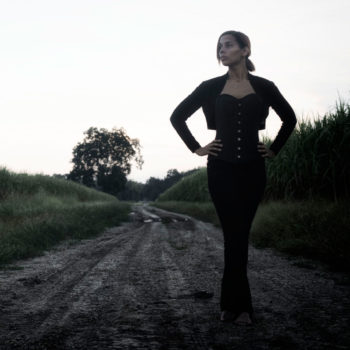Rhiannon Giddens is a singer, songwriter, fiddler, and banjo maestro. She also makes up a third of the Grammy-winning folk band Carolina Chocolate Drops. And if that wasn’t enough, you can see her flex her acting muscles on the TV show “Nashville” as a banjo-toting social worker.
Her second solo album comes out this week. It’s called “Freedom Highway,” named after the civil rights anthem. Here she is with a playlist that mixes blues, opera, satire, and more.

Leontyne Price – “O Patria Mia”
Rhiannon Giddens: My first song is Leontyne Price singing “O Patria Mia,” 1962.
Back in the ’60s, “The Bell Telephone Hour” was a thing. It was on national TV, and they would have different singers come in and recreate scenes from opera.
Leontyne Price is just one of the best. She opens her mouth… and I think I read somewhere that her own voice would move her to tears.
Opera singing gets this bad rap. You know: This large woman with braids and horns singing this horrible music! But opera’s just so amazing when it’s sung beautifully. And the purity of her voice… I mean, particularly that last note is just unreal.
She managed to transcend race, really, in terms of just people saying, “She’s one of the greats.” Not, “She’s one of the great black sopranos,” but, “She’s one of the greats.” And, as a black female entertainer, I’m always thinking about the people who managed to make it through those limitations to make it. They couldn’t be mediocre. They had to be amazing.
Tom Lehrer – “The Vatican Rag”
My second song is “The Vatican Rag” by Tom Lehrer. Tom Lehrer, he was almost a standup comedian. You can hear his full audiences, and people really responding to what he’s saying. And he wrote political and topical songs about really serious stuff, but he did it in this twisty way.
He’s poking fun at the Catholic church. He had these lyrics that were just killer. I mean, “Two, four, six, eight / time to transubstantiate!”
I’m just a nerd. I was listening to this stuff when I was, like, 12 years old, you know what I mean? My godmother was a big influence on me and passed these tapes to me. So, they have skips in them — I knew all the skips. It was hilarious. And I appreciated them on one level, and then I’d go back at a little bit older and go, “Oh, that’s what he meant by that!” That’s the amazing thing about this kind of music and writing, is that you can appreciate it on whatever level you can.
Mississippi Sheiks – “Sitting on Top of the World”
So, the Mississippi Sheiks are a wonderful fiddle and guitar trio. They were very, very well-known in their time, in the ’20s. I know that my fiddling has been very influenced the Mississippi Sheiks’ fiddling. It just gives you this kind of “ooooh” feeling.
There was this rich, rich history of black string band music in America. It goes all the back to the plantation. And there’s lots of people who’ve heard Adele and all of these people, and I love that music too, but my whole career is based on sort of shining a light in corners of American history. And then you get to the corner and you realize it’s actually an entire house, you know?
Rhiannon Giddens – “We Could Fly”
The last song for my dinner party is a song by myself and Dirk Powell, and it’s called “We Could Fly.”
I had been thinking about this African American folktale called, “If People Could Fly” by Virginia Hamilton. And it was about these people from Africa who could fly, and then they were captured and put on ships, and they lost their wings.
So, at some point, one of the elders remembers the magic words and sings them, and the people who could fly rose up out of the fields and flew away. And the people who couldn’t fly, they told the story of the people who could fly to their children, who told it to their children, and then so on and so forth. And it’s just this beautiful allegory of hope, and looking up, rather than looking down.


